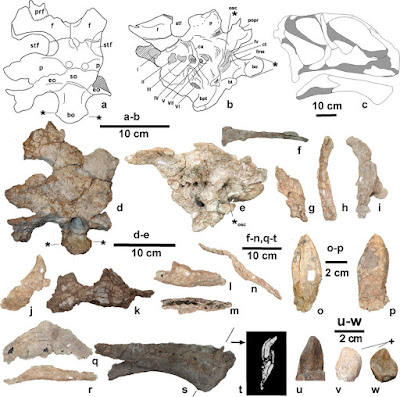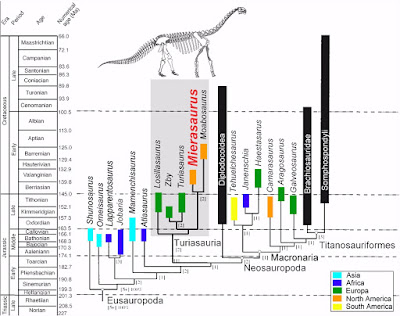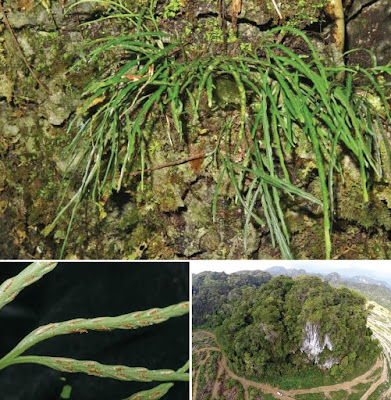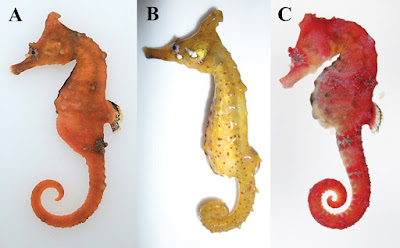[Most Recent Entries] [Calendar View]
Saturday, November 4th, 2017
| Time | Event | ||||||||
| 8:01a | [Paleontology • 2017] Mierasaurus bobyoungi • Descendants of the Jurassic Turiasaurs from Iberia Found Refuge in the Early Cretaceous of western USA
Abstract A new, largely complete eusauropod dinosaur with cranial and postcranial elements from two skeletons, Mierasaurus bobyoungi gen. nov., sp. nov. from the lower Yellow Cat Member (Early Cretaceous) of Utah (USA), is the first recognized member of Turiasauria from North America. Moreover, according to our phylogenetic results, Moabosaurus utahensis from the lower Yellow Cat Member of Utah (USA) is also a member of this clade. This group of non-neosauropod eusauropods, which now includes five genera (Losillasaurus, Turiasaurus, Mierasaurus, Moabosaurus and Zby), was previously known only from the Jurassic of Europe. These recent discoveries in Utah suggest that turiasaurs as a lineage survived the Jurassic-Cretaceous extinction boundary and expanded their known range, at least, into western North America. The revised spatiotemporal distribution of turiasaurs is consistent with the presence of a land connection between North America and Europe sometime during the late Tithonian to Valanginian (c.147-133 Ma). Mierasaurus and Moabosaurus are the only non-neosauropod eusauropods known from North America, despite being younger than the classic neosauropods of the Morrison Formation (c.150 Ma). 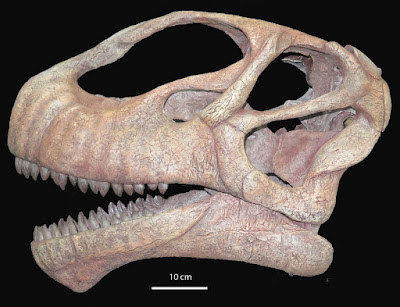
Systematic Palaeontology Dinosauria Owen, 1842 Saurischia Seeley, 1887 Sauropoda Marsh, 1878 Eusauropoda Upchurch, 1995 Turiasauria Royo-Torres, Cobos and Alcalá, 2006 Mierasaurus bobyoungi gen. nov., sp. nov. Etymology: Genus named for Bernardo de Miera y Pacheco, Spanish cartographer and chief scientist for the 1776 Domínguez-Escalante Expedition: the first European scientist to enter what is now Utah. The species name acknowledges the importance of the underappreciated research by Robert Young on the Early Cretaceous of Utah. Holotype: A partial skeleton of a single individual (UMNH.VP.26004), comprising disarticulated cranial and postcranial elements from the type site (Doelling’s Bowl). We regard this as subadult because it is a relatively large animal with unfused vertebral centra and neural arches in some dorsal vertebrae. This individual includes a partial skull and jaw, teeth, atlas, 8 cervical vertebrae, 11 cervical ribs, 11 dorsal vertebrae, 6 dorsal ribs, 6 sacral ribs, 15 caudal vertebrae, two chevrons, right scapula and partial left scapula, left radius, left ulna, left manus, complete pelvic elements, both femora, left tibia, left fibula, left astragalus and left pes.
 Type locality and horizon: All Mierasaurus remains discussed herein are from Doelling’s Bowl bonebed, UMNH VP.LOC.1208 (Utah Loc. 42Gr0300v) within the lower Yellow Cat Member (below the marker calcrete), Cedar Mountain Formation, on lands managed by the U.S. Bureau of Land Management in northern Grand County, east-central Utah. In a preliminary report in a conference abstract, detrital zircon dating indicates maximum ages ranging from ~136.4 ± 1.1 Ma and ~132 Ma for lower Yellow Cat Member and ~137.2 ± 2.0 Ma for upper Yellow Cat Member. The combination of these data with the upper Berriasian-Valanginian age based on ostracods and charophyte fauna for the upper Yellow Cat Member indicates a conflict in the maximum age traditionally considered for it 124.2 ± 2.6 Ma (see Supplementary Information). All of these data suggest a potential age of late Berriasian-early Aptian (c.142-124 Ma) for the Yellow Cat Member. Doelling’s Bowl has produced the iguanodont cf. Iguanocolossus sp., a new species of polacanthid ankylosaur, a large allosauroid theropod (teeth), and the dromaeosaur Yurgovuchia doellingi. Exact locality information will be provided to qualified researchers on request through the Natural History Museum of Utah or the Utah Geological Survey. Diagnosis: A turiasaurian sauropod possessing the following features (autapomorphies marked by *): *the otosphenoidal ridge extends from the anterior surface of the paroccipital process, near its ventral margin and is restricted to the medialmost part of the latter process (Fig. 2b); *the occipital condyle has a pair of rounded ridges extending dorsoventrally, one on either lateral face of the condylar articular surface (Fig. 2a–d); *the atlantal intercentrum (Fig. 3e,f) bears a pair of depressions in the medial surface, facing posteromedially, each of which receives the anterolateral margin of the odontoid process; a well-developed spinoprezygapophyseal lamina extends anteriorly (Fig. 3a–d, g–m) as a low ridge onto the lateral surface of the prezygapophyses roofing a lateral fossa on prezygapophyses in middle and posterior cervical vertebrae (shared with the diplodocine Kaatedocus26); *cervical ribs bear a ridge or bulge on the lateral surface of the tuberculum, immediately posterior to the base of the anterior process (Fig. 3n–v); dorsal neural arches lack posterior centroparapophyseal laminae; *lateral depression on the distal ramus of haemal arches (Fig. 5g,h); metacarpal I longer than metacarpal IV, shared with Macronaria27 (Fig. 5m); a very short ischium compared to pubis length (ischium:pubis length ratio = 0.75) (Fig. 5d–f); the midpoint of the fourth trochanter placed in the proximal part of the femur (Fig. 5a); femur with subequal distal condyles (Fig. 5k); and pedal unguals 2 and 3 compressed dorsoventrally (Fig. 5l,o). 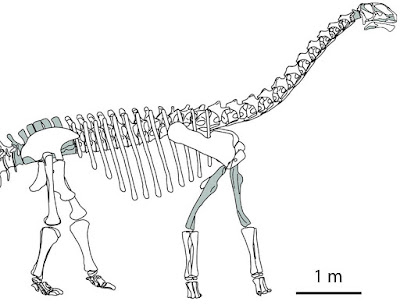
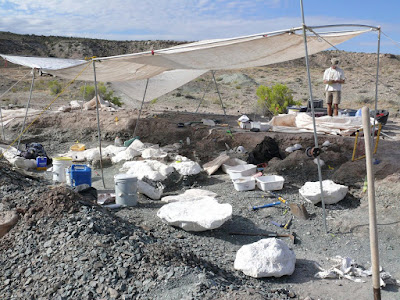 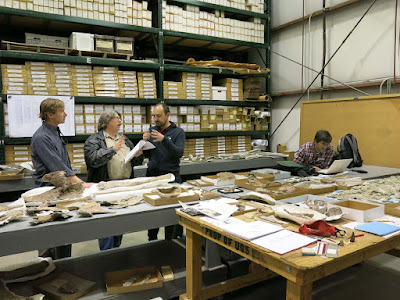 Rafael Royo-Torres, Paul Upchurch, James I. Kirkland, Donald D. DeBlieux, John R. Foster, Alberto Cobos & Luis Alcalá. 2017. Descendants of the Jurassic Turiasaurs from Iberia Found Refuge in the Early Cretaceous of western USA. Scientific Reports. 7, Article number: 14311. DOI: 10.1038/s41598-017-14677-2 Identificado un nuevo #dinosaurio de #Utah (#EEUU) con orígenes en #Teruel (#España) 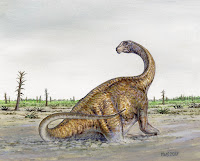 | ||||||||
| 8:35a | [Botany • 2017] Asplenium merapohense (Aspleniaceae) • A New Species from the Peninsular Malaysia
Abstract A new species of Asplenium is described from two collections made on limestone hills in Peninsular Malaysia. Conspicuous by its extremely narrow pinnae, it is probably allied to A. salignum but differs in sufficient characters (scale size, size and shape of lamina, venation and sorus length, position and orientation) to be a species in its own right. Keywords: Asplenium, limestone, flora, morphology, taxonomy Asplenium merapohense R. Jaman & K. Imin, sp. nov. Diagnosis: Similar to Asplenium salignum in its short creeping rhizome, tuft of simple or once pinnate fronds dentate with rounded marginal teeth but A. merapohense is distinct in its shorter, much narrower pinnae 3.4–7.1 × 0.2–0.3(–0.45) cm (vs. 6–27 × 0.9–3.7 cm) and shorter sori, which are 2–6 mm long and lie parallel to the midrib (vs. sori 4–13 mm long angled at 45° to the midrib). Distribution: Endemic in Peninsular Malaysia, from Pahang, Merapoh (Gua Gajah) and Kelantan, Gua Musang District (Gua Panjang). Etymology: It takes its name from the type locality. Ecology: Restricted to karst limestone hills where it grows on steep rock faces in sheltered conditions at 180–348 m altitude. It is a rare and very local species (Figure 2). Razali Jaman, Imin Kamin and Ruth Kiew. 2017. Asplenium merapohense (Aspleniaceae), A New Species from the Peninsular Malaysia. PhytoKeys. 89; 85-90. DOI: 10.3897/phytokeys.89.20875 | ||||||||
| 6:22p | [Ichthyology • 2017] Seahorses of the Hippocampus coronatus complex (Teleostei, Syngnathidae): Taxonomic Revision, and Description of Hippocampus haema, A New Species from Korea and Japan
Abstract Morphological and molecular analyses were conducted on 182 specimens belonging to the Hippocampus coronatus complex (H. coronatus sensu lato), collected in Korea and Japan 1933–2015, in order to clarify the taxonomic status of the species within this complex. Three species are recognized based on the shape of the coronet, the number of trunk rings (TrR) and tail rings (TaR), and presence or absence of a wing-tip spine (WS) at the dorsal fin base. Hippocampus coronatus Temminck & Schlegel, 1850 (H. coronatus sensu stricto), is diagnosed by 10 TrR, 37–40 TaR, an extremely high coronet (55.7–79.0 % head length) with four tips on the corona flat (CoT), and one WS. Hippocampus sindonis Jordan & Snyder, 1901 is diagnosed by 10 TrR, 35–38 TaR, a moderately high coronet (36.3–55.4 % HL) with five CoT, and no WS. A new species, Hippocampus haema is described on the basis of 140 specimens, characterized by 10 TrR, 35–38 TaR, a moderately high coronet (34.1–54.9 % head length) with four CoT, and two WS. Hippocampus haema is only known from the Korea Strait, western Kyushu, and East/Japan Sea. Recognition of the three species is supported by differences in mitochondrial DNA fragments (cytochrome b, 16S rRNA, and 12S rRNA). Keywords: Genetic distance, morphology, molecular systematics, Pacific Ocean, taxonomy
Hippocampus coronatus Temminck & Schlegel, 1850 English name: Crowned seahorse, New Korean name: -haema, Japanese name: Tatsu-no-otoshigo Diagnosis: A species of Hippocampus having a bony body; double gill openings; ring (R: TrR + TaR) 10 + 37–40, mode 10 + 39 (lectotype: 10 + 38); extremely high coronet, straight or inclined backwards; CoT 4; CHGO 43.0–60.1 % HL; CHMC 55.7–79.0 % HL; WS thick and recurved. Distribution: Southeastern coast of Honshu (Japan), from Izu Peninsula (Shizuoka Prefecture) to Boso Peninsula (Chiba Prefecture) (Fig. 1). Hippocampus coronatus lives in weed habitats, especially in floating Sargassum (Kuiter 2009; Senou 2013), within shallow areas (0–20 m depth). Etymology: The Latin word coronatus means crowned. The new Korean name, Wanggwan-haema means ‘crowned seahorse’, in agreement with the English and scientific names. In fact, Haema, which has the connotation ‘common’ and ‘fish species belonging to the genus Hippocampus’ in Korean, has been used to name seahorses commonly found in Korea, whereas Wanggwan-haema has been informally used to refer to H. coronatus in Korean. In addition, the word wanggwan [crown] is more suited for H. coronatus, whose coronet is considerably higher than that of H. haema. The Japanese name Tatsu-no-otoshigo literally means ‘dragon’s bastard child’. Hippocampus sindonis Jordan & Snyder, 1901 English name: Painted seahorse, Korean name: Sindo-haema, Japanese name: Hanatatsu Diagnosis: A species of Hippocampus having a bony body; double gill openings; R 10 + 35–38 (holotype: 10 + 37); coronet moderately high; CoT 5; CHGO 26.8–41.0 % HL; CHMC 36.3–55.4 % HL; a very blunt or truncated spine on the dorsal fin base; no WS on dorsal fin base. Distribution: Southeastern coast of Honshu (Japan), from Tanabe (Wakayama Prefecture) to Boso Peninsula (Chiba Prefecture) (Fig. 1). Hippocampus sindonis lives in a wide range of habitats, from shallow high-energy algae reefs to soft bottom habitats (Kuiter 2009), at 2–30 m depth (Senou 2013). Etymology: The specific name sindonis was derived from the name of M. Sindo, an assistant curator of fishes at Stanford University (Jordan and Snyder 1901; Lourie 2016). The English name was coined by Kuiter (2009). The Japanese name Hanatatsu literally means ‘hana (flower or blossom, which indicates gorgeous) + tatsu (dragon, or the abbreviation of the word “Tatsu-no-otoshigo: seahorse”)’, and refers to the beautiful color and skin filaments of the species. 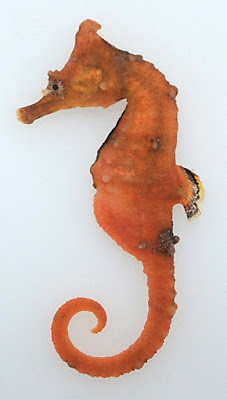 Hippocampus haema sp. n. New English name: Korean seahorse, Korean name: Haema, New Japanese name: Himetatsu Hippocampus coronatus: Jordan and Snyder 1901: 19; Mori 1928: 5; Boeseman 1947: 195; Mitani 1956: 30; Chyung 1977: 272; Araga 1984: 89; Senou 1993: 489 (right fig.), 1294; Kim and Lee 1995: 76; Nakamura 1999b: 125; Senou 2000: 536; Choi et al. 2002: 141; Senou 2002: 536, 1508; Kim et al. 2005: 203; Choi et al. 2006; Yoshino and Senou 2008: 76; Kohno et al. 2011: 127; Senou 2013: 635, 1911; Han et al. 2014: 423 (non Temminck & Schlegel). Hippocampus cf. coronatus: Kuiter 2009: 128. Hippocampus sindonis: Nakamura 1999a: 124; Yoshino and Senou 2008: 76; Kim et al. 2013: 42 (non Jordan & Snyder). Hippocampus kuda: Kim et al. 2001: 67, Myoung et al. 2002: 74 (non Bleeker). Hippocampus sp.: Kim and Ryu 2017: 110. Diagnosis: A species of Hippocampus having a bony body; double gill openings; R 10 + 35–38, mode 10 + 36 (holotype: 10 + 36); coronet moderately high and turned back on top; CoT 4; CHGO 22.7–41.6 % HL; CHMC 34.1–54.9 % HL; a WS on the dorsal fin base. Distribution: Korea: southern and southeastern coasts of the Korean Peninsula (from Soan Island to Ulsan); Japan: western coast of Kyushu (western Kagoshima Prefecture), northwestern coast of Honshu (from Kyoto Prefecture to Akita Prefecture) (Fig. 1). Lives in floating Sargassum and weeds on shallow soft bottom habitats from 0–18 m depth (e.g. Kim et al. 2016). Etymology: The Korean word Haema means ‘seahorse’, which connotes ‘representative’ and ‘common’. Thus, the scientific and Korean names Haema were chosen to indicate that this seahorse is the one most commonly found in Korea. The Japanese name Himetatsu means ‘princess seahorse’ or ‘dwarf seahorse’, and refers to its lower coronet and smaller body compared to H. coronatus. Sang-Yun Han, Jin-Koo Kim, Yoshiaki Kai and Hiroshi Senou. 2017. Seahorses of the Hippocampus coronatus complex: Taxonomic Revision, and Description of Hippocampus haema, A New Species from Korea and Japan (Teleostei, Syngnathidae). ZooKeys. 712: 113-139. DOI: 10.3897/zookeys.712.14955 |
| << Previous Day |
2017/11/04 [Calendar] |
Next Day >> |

